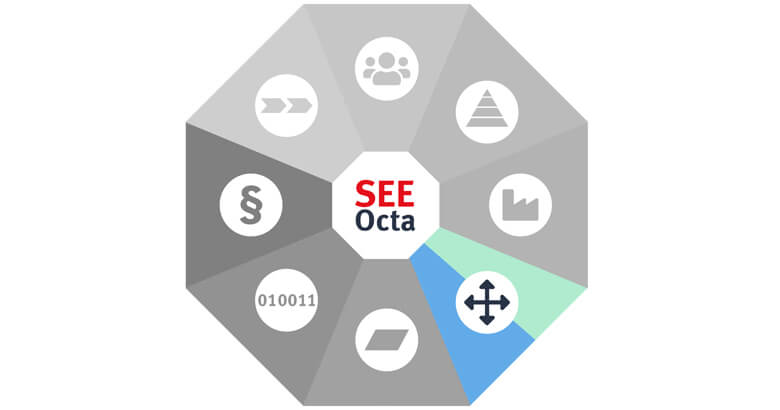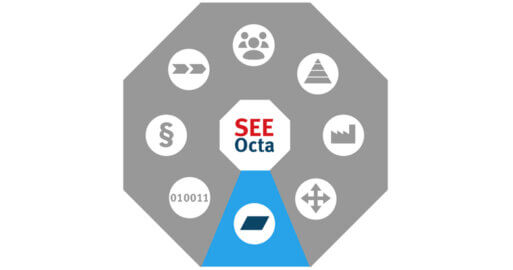SEEOcta: Strategy – the way to digital maturity

Strategy is a many-headed creature. If an organisation is aiming to become a digitally mature company, they need a corporate strategy, digital strategy, digitalisation strategy and IT strategy, all focussing on different aspects, yet all walking hand in hand. In this article from the SEEOcta series, find out how these four types of strategy depend on one another, and what an organisation desiring digital maturity needs to consider. At the same time, learn to recognise the optimisation trap, and how to avoid it.
Four strategies leading to one goal
Digital maturity and digital transformation – these buzzwords turn up when defining goals in almost every company, from sole traders to a global congolomerate. Even the strength of an internet connection or the ability to send invoices digitally are elements of digital maturity and affect even the smallest firms. There are opportunities present for all in efficiently managing customer and product data, managing machines and production processes, aggregating data, generating information from it and turning it into lucrative business models. And in order to seize and exploit these opportunities, you need well considered, coordinated strategies which work together to essentially reach one core goal; to ensure the long-term economic success and ultimately survival of your company. How are the corporate, digital, digitalisation and IT strategies connected, and what are the differences? Let’s have a look:
Corporate strategy and digital strategy
A corporate strategy is part of a business plan. It sets out how corporate goals and economic success are to be achieved in the long term. A digital strategy is part of the corporate strategy. It defines what needs to be done and how to do it to meet corporate goals in digital markets. A digital strategy identifies how an existing business model can be transformed into a digital business model so that a company can achieve competitive advantages by also growing in digital markets. The digital strategy should provide answers on how to deal with the challenges and opportunities of digitalisation.

A very important distinction between digital and corporate strategy is their scope. Digital strategy focuses on technology, not on corporate culture. It uses technology as a way of adapting business models. Modern technologies enable the business units to drive their digital transformation. This process has a particular impact on
- Customer experience (CX),
- operative processes and
- business models.
But watch out! Digital strategy is not the same as IT strategy…
Digital strategy and IT strategy
A digital strategy should identify and exploit the potential in an organisation to establish digital business models. This requires modern technology.
An IT strategy is geared towards modernising and transforming the technology to the extent that it optimally supports the digital strategy.
A company’s digital transformation is only possible when the IT and digital strategies walk hand in hand.
Digitalisation strategy – The basis of a good digital strategy, but it only works alongside a good IT strategy
Just to add to the confusion, often a digital strategy is also based on a comprehensive digitalisation strategy, which in turn needs to be planned and implemented through a wide-ranging IT strategy. A digitalisation strategy sets out how analogue data can be transformed into digital data, not only to design more efficient and transparent workflows, but simply also to make digital data available for a digital strategy. Some possible techniques include OCR and a digital inbox.
Mit der Digitalstrategie zur digitalen Reife
The goal of a digital strategy is to drive the digital transformation in a company, exploiting or creating potential for improving and enabling digital business models. You can start by optimisimg existing processes and structures. It has, however, been shown that sooner or later you reach a point where you can no longer optimise without adding more and more resources. Eventually, the costs outweigh the benefits. How can you avoid this optimisation trap? Dare to consider restructuring. However, you need to start with an open mind and the willingness to try something different:
- Challenge the old way of thinking
If a company is heading towards the optimisation trap, it is time to adapt the old way of thinking to the new circumstances. However, this is easier said than done. It’s the way it’s always been done, and always worked well in the past, didn’t it? Ingrained ways of thinking can be a real obstacle to optimising through restructuring. This leads us on to the next point: - Encourage a willingness to take risks
Restructuring requires a willingness to take a risk for it involves breaking down old routines so you don‘t fall into the optimisation trap. If throwing more resources at a problem cannot solve it, it important to create space to try out new ideas. When else are you going to have a greater chance of success in trying something new?
However, before getting too excited about the opportunity to break with the old ways, don’t forget to plan in space to reflect and properly consider the way forward. This is a paradigm shift which needs to be carefully prepared across all departments. Our SEEOcta blog post on change management looks at this in more detail.
Developing a good digital strategy is one of the most important steps in being able to successfully implement and use the opportunities in digital processes and business models. A company’s digital strategy consolidates organisational goals, employees‘ needs, and the possibilities offered by technology. It is an important step to becoming a digitally mature organisation.
The process of digital transformation requires processes throughout the organisation to be coordinated, and significantly impacts on corporate culture. Therefore, it involces considering all eight perspectives in the SEEOcta model.
Thank you for your message
We appreciate your interest in SEEBURGER
Get in contact with us:
Please enter details about your project in the message section so we can direct your inquiry to the right consultant.
Written by: Rolf Holicki
Rolf Holicki, Director BU E-Invoicing, SAP&Web Process, is responsible for the SAP/WEB applications and digitization expert. He has more than 25 years of experience in e-invoicing, SAP, Workflow and business process automation. Rolf Holicki has been with SEEBURGER since 2005.





